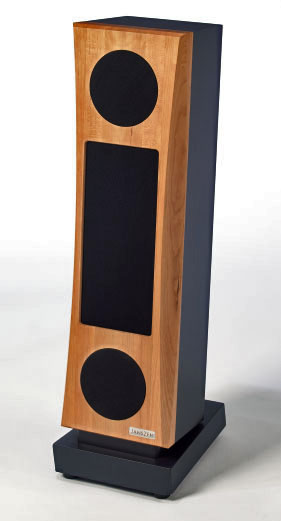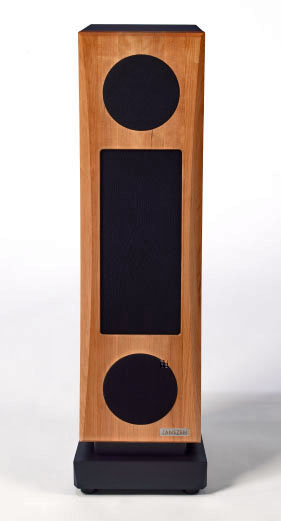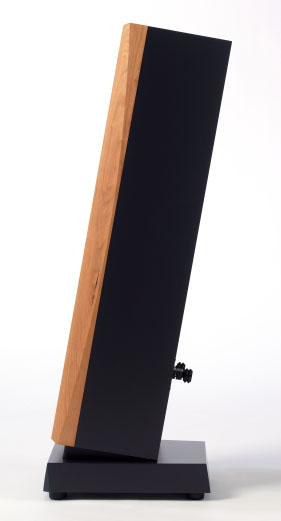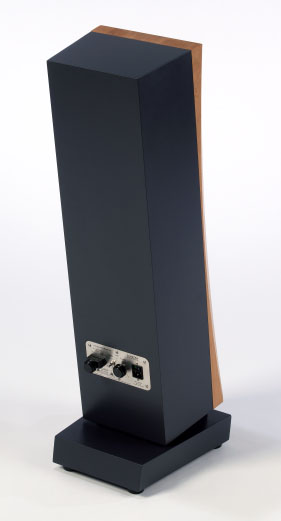|
|
You are reading the older HTML site
Positive Feedback ISSUE 68
janszen electrostatic zA2.1 Loudspeakers as reviewed by Roger S. Gordon
The Janszen name has been associated with consumer electrostatic loudspeakers since their inception. Arthur Janszen, who began working with electrostatic loudspeakers during World War II at the Harvard Underwater Sound Laboratory, had the first full range High End electrostatic speaker in field test in 1957. By 1959 Arthur Janszen was working for KLH and the first full-range Janszen designed electrostatic speaker was on the market. Over the following years Arthur Janszen developed electrostatic speakers for KLH, Acoustech (division of Koss Electronics), and ERC (Electrostatic Research Corporation). Arthur also contributed to the design of certain speakers produced by Neshaminy and Electronic Industries. The current Janszen electrostatic loudspeakers, which are the subject of this review, are designed by David Janszen, Arthur's son. The current Janszen loudspeakers came to my attention due to a demonstration that David Janszen put on for our local audio society (Music and Audio Guild of San Diego). I could not attend the demonstration. However, one of the attendees (Mr. A) was able to take the demo loudspeakers home with him so that he could audition them. The audio society members who dropped by Mr. A's house for a listen were raving about the sound from these small floor standing electrostatic loudspeakers. Wanting to see what all the fuss was about I went to hear the speakers and was very impressed. I then contacted David Janszen and we agreed that I could review the speakers which were eventually transferred from Mr. A's house to mine. With the zA2.1's missing from Mr. A's listening room life just wasn't the same for him. So, he bought his own pair of zA2.1's. The first month I had the zA2.1's in my listening room I tried putting the loudspeakers in different positions. With the help of a friend, I ran full room frequency sweeps (25 - 20kHz) as I waltzed the speakers around the room. The results of these sweeps were plotted using REW (Room EQ Wizard Room Acoustics Software). The zA2.1's have a 3-position toggle switch that adjusts the bass response from 1kHz on down by -3dB, 0dB, and +3dB. Frequency sweeps using these three bass adjustments were done with the speakers placed up against the front wall and also two feet in front of the front wall. These additional sweeps were also plotted using REW. What these plots and my ears told me was that the best speaker position was with the listening spot at the apex of an equilateral triangle with the speakers pulled two feet out from the front wall. The Owner's Manual for the zA2.1's suggests having the speakers and the listening position form an equilateral triangle. The manual is right.
Having gotten the speakers dialed in, I then proceeded to listen. During some of these listening sessions I invited local audio society members to drop by and have a listen. I wanted to get other people's opinions as to what the zA2.1's were doing right and doing wrong. Everyone who came by to listen was favorably impressed. One visitor was so impressed that he ordered his own pair of the zA2.1's the very next day. As the time approached for me to ship the speakers back to the factory I spent quite a lot of time switching back and forth between my reference speakers (VMPS RM30) and the zA2.1's. Based on my listening comparisons I came to the conclusion that the zA2.1's were better than my RM30's and that I could not part with the zA2.1's. I bought the review pair. What is it about the zA2.1's that made the three of us each buy a pair? The three of us have very different audio equipment, different listening rooms, and also very different tastes in music. Yet after talking with them it appears that all three of us fell in love with the zA2.1's for pretty much the same reasons. These reasons can be summarized as follows: 1. Quality and quantity of the bass. 2. Transparency/resolution of the sound 3. Imaging 4. Room filling sound 5. Musicality 6. Ease of setup Before we get into the details of the above six reasons, here is some background on the zA2.1's. The zA2.1's are small floor standing speakers 91cm x 26cm x 22.6 cm (hwd) or 35.9" x 10.2" x 8.9" (hwd) and the speakers rest on a plinth which is 6cm x 30cm x 35 cm (hwd) or 2.5" x 12" x 14" (hwd). The speakers weigh 27 kg or 60 pounds each. The zA2.1's are actually 2.5 way speakers. There are two 7" cone drivers on the top and bottom of the speaker with the electrostatic panel in the middle. All of the drivers/panel are enclosed - no dipole. There is one crossover, a first order crossover at 500Hz. The electrostatic panel is actually split vertically into two halves. One half is full range. There is secondary partial first order crossover that rolls off the treble of the other half panel. Having the entire panel area carry the midrange and one half of the panel also carry the treble accounts for the extra .5 of the 2.5 way designation. Sensitivity is a conservative 87dB/1W/1M (pink noise). The recommended amplifier power range is from 25W - 150W RMS/ch 8 ohm. Impedance is 6 ohms nominal, 4 ohms minimum, and 10 ohms maximum. The capacitance reflected back to the amplifier is relatively small and decoupled by some series resistance. Thus, there is no danger of amplifier instability from unusual load reactivity. The in room frequency response is conservatively stated at 40Hz - 20kHz +/- 3dB on axis (in room). Now let's start talking about each of the above six reasons. Bass - Quality and Quantity All of the people that I talked to that have heard the zA2.1's were astonished at how such a small loudspeaker could produce such loud, forceful bass. All of these people heard the zA2.1's pulled away from the front wall with the bass toggle switch in the +3 dB position. In my room, with the speakers against the front wall, the -3 dB toggle switch position was necessary to prevent too much bass. The room frequency sweeps that I ran consistently showed that the bass was down 0dB at 25Hz. 25Hz is subwoofer territory. The lowest frequency produced by an acoustic instrument is 41Hz from a four string double bass or 31Hz for a five string double bass. I have always used a large 15" subwoofer (20Hz to 80Hz) with my RM30's. With the zA2.1's I don't need a subwoofer and I don't miss it. The quality of the zA2.1's's bass was also as good as the quantity. The bass was articulate. When the Big Bass Drum was hit on a Telarc recording you could hear the mallet strike the skin, the initial impact, and the decay as the reverberations died away. As the bass got lower in frequency and louder in volume the bass did not get muddy as it does with some woofers. On the Delos CD of Hovhaness's Symphony No. 50 "Mount St. Helens" the recreation of the eruption was amazing. The third movement starts off quietly as one is walking through a pine forest in the wilderness. Suddenly the volcano erupts. I have played this recording many times on my system. The transition from forest quiet to 'the world is coming to an end' is always startling. However, the first time I played it on the zA2.1's I literally jumped out of my seat. The transition from pp to ffff was instantaneous. Even after playing the 'eruption' several times with the zA2.1's I am still amazed at the speed, articulation, and sheer loudness of the sound. As another example, take the Sony CD of Vangelis's Mythodea. The percussion section used in this recording is huge with multiple sets of timpani. As the different timpanists play their timpani sets the individual notes from each set of timpani is clearly discernible - they don't all blend together as a muddle mess as happens with some woofers. Another thing about the bass of the zA2.1's is that the 7" cone woofers blend seamlessly with the electrostatic panels. Neither I nor any of the other people that listened to the zA2.1's that I spoke to could tell where the crossover was between the 7" woofers and the electrostatic panel. Getting cone woofers to blend with electrostatic panels is not an easy task. There have been many examples over the years of electrostatic speakers built by highly respected High End companies where the bass coming from the cone woofers did not blend with the electrostatic panels. Sometimes the problem was that cone woofers did not seem to respond as quickly as the electrostatic panels. The woofers always seemed to be lagging behind. Sometimes the problem was that the tonality of the woofers and the electrostatic panels did not seem to match. If the woofers and electrostatic panels don't match each other in all respects there will definitely be a negative impact the listening experience. Transparency/Resolution of the Sound Traditional cone drivers have a problem. Because the cones have mass, they can not stop and start instantaneously. This lag in the cones starting and stopping means the notes generated by the cone does not start as soon as they should nor do they terminate as soon as they should. This delay in starting and stopping muddles the sound and obscures inner details. On a good cone driver you really cannot hear this lack of clarity unless you do an A-B-A comparison with a electrostatic speaker. On an electrostatic speaker the air is moved by a very thin, light weight membrane that has very little mass. Thus, an electrostatic speaker membrane can stop and start much faster than a cone driver. Faster starts and stops means less muddying of the sound. Hence, electrostatic speakers should provide more inner detail and more clarity. It is this detail/clarity that has made electrostatic speakers so popular over the years. For audiophiles who value detailed, high resolution sound electrostatics have usually been the favored choice. Of course, just because the loudspeaker is an electrostatic does not mean that it is ultra high resolution. Like everything else, the devil is in the details. My RM30 loudspeakers have panels to cover the midrange (500 - 5kHz). These midrange panels have always delivered what I thought was very detailed sound. I could hear detail in recordings that I usually could not hear on other speakers playing the same recordings. With the zA2.1's I am hearing more detail on most recordings than I heard with the RM30's. This detail could be background noises such as hearing the air conditioning in the recording hall cycling on and off, hearing Glenn Gould humming to himself as he played the piano, or the subway trains running under Kingsway Hall on a London/Decca recording. Or the detail could be subtle variations in the micro dynamics of Kurt Cobain's voice on the first track (About a Girl) on Nirvana's Unplugged in New York album on the Geffen label (available as CD or LP. I prefer the LP). Doing A-B-A comparisons between the zA2.1's and my RM30's using the Philips label LP of Friday Night in San Francisco, a live recording with Al Di Meola, Paco de Lucia, and John McLaughlin, showed that the zA2.1's revealed more inner detail. There was more noise of the fingers sliding up and down the strings, more subtle changes in dynamics, more subtle shadings of the sound of the guitars. On the zA2.1's the recording just sounded more like the real event than through the RM30's. The difference between the 'liveness' of the zA2/1s and RM30's was not great, but it was definitely there. Imaging Electrostatic loudspeakers are known for their imaging. This is a combination of very high resolution which provides the subtle details that you need for proper imaging and also because of reduced sidewall reflections. Electrostatic speakers send out a beam of sound in the direction that they are aimed. While there is some sound energy going to the sides it is significantly reduced from most other loudspeakers of different designs. If first reflections from the floor, ceiling, or any of the walls are strong and arrive at the listener's ears shortly after the direct sound reaches the listener, the brain can not ignore this first reflection data and the listener's ability to locate instruments/voices in three dimensional space is lessened. If you are sitting in the sweet spot, the zA2.1's do a very good job of recreating the sound stage and location of the instruments/people that are on the recording. I have heard loudspeakers that can produce a better holographic image than the zA2.1's. However, I do not hear that same pinpoint holographic imaging when I go to a symphony concert nor when I hear a acoustic guitarist playing on the street. I think the imaging of the zA2.1's is more like what we hear at an non-amplified acoustic performance.
In my room the sweet sport for the zA2.1's was about 2 feet wide; i.e. you did not have to put your head in a vise in order to prevent it from slipping out of the sweet spot. When people came over to my house to listen to the zA2.1's they would sit in a row about twelve feet wide. While everyone agreed that the imaging and sound quality was best at the sweet spot, the sound quality was still quite enjoyable regardless of where you sat. At one listening session I remember sitting at the left end of the row and looking down the line. Everyone, including the person at the far right, had their eyes closed and were either nodding their head or tapping their feet in time with the music. Room Filling Sound The zA2.1's are small loudspeakers. Yet they can fill a large room with sound. My listening room does not have a back wall. The rear of the listening room enters out into a large space. When I hired Rives Audio to sound treat my listening room they suggested that I completely close off the rear end of the room with RPG Variscreens. Variscreens are two 2' by 8' or .6m by 2.4m sound panels hinged together on their long side so that they can stand upright by themselves when folded into a "V" shape. With the Variscreens in place my listening room is an enclosed area of about 4000 cubic feet or 113 cubic meters.
When I initially had audio friends start coming over listen one of them commented that the zA2.1's sounded a little constrained at high volume. That had not been a problem when he listened to the same speakers at Mr. A's home where the speakers were in a large room of over 10,000 cubic feet or 283 cubic meters. After my friend left I folded the Variscreen panels closer together and opened up the rear wall such that rear wall was now 2/3rds open and only 1/3rd covered by the Variscreens. I tried playing some music at high volume; e.g. Nine Inch Nails Pretty Hate Machine CD, on the tvt label, Blue Cheer Summertime Blues on a 45rpm 7" single, Twisted Sister Love is for Suckers LP, on the Atlantic label, etc. The constrained sound that my friend had brought to my attention was now gone. I tried listening to other music at a lower volume and I did not notice any real change in sound quality between having the back of the room open or closed. Musicality I define musicality as the ability of a piece of audio gear to get you involved with the music on an emotional level. Does the music played back through the piece of gear make you want to wave your air baton, play your air guitar, or bang your head in time with the music? When a piece of music has finished playing do you jump up out of your seat, thrust your fist into the air, and shout Yeahh! The zA2.1's made me do all of those things. The people that came over to listen to the zA2.1's were a bit more restrained. However, when they were playing their own recordings they would close their eyes, nod their head or tap their toes in time with the music all the while having a smile on their face. Along with being able to make an emotional connection with the music, a piece of audio gear should also be neutral. It should not add its own sound to the music. I have auditioned audio gear that added a euphonic coloration to the music. While enjoyable in the short term, over the long term I don't want sound that is not what I hear when I listen to live acoustic music. I have kept my RM30's against all other challengers because the RM30's were very close to neutral. They did not seem to add any sound of their own to the music. To my ears, the zA2.1's are as neutral as the RM30's. Ease of Setup The zA2.1 speakers are easy to place into a room. First off, the zA2.1's are small and unobtrusive. Secondly, they are nicely finished - furniture quality. Thirdly, they can be located just about anywhere. They can be placed up against the front wall if the spouse doesn't want speakers intruding into the living room or they can be placed a few feet from the front wall, or pulled well out into the room. Weighing only 27kg or 60 pounds the speakers are easy to walk around the room. The direct beaming of the electrostatic panels helps reduce sidewall reflections in case you have not been able to place sound treatment materials on your sidewalls. While the best sound will only be obtained if you spend time trying out various positions for the speakers and listening position, you can get pretty close to the best sound without spending too much time. The only real drawback to speaker placement is that the zA2.1's, like all electrostatic panels, need a source of electricity in order to charge the electrostatic panels. The amount of current needed to charge the panels is only one tenth of a watt and any power cord will suffice. Conclusion The zA2.1's do a lot of things right. However, they are not perfect. Fortunately, their shortcoming are more errors of omission rather than commission. For example, they cannot play at concert arena sound levels; i.e. 135dB. According to the factory specifications they can only play at 108dB at 13 feet or 4 meters in a 3600 cubic feet or 100 cubic meter room. In a small room, 1728 cubic feet or 49 cubic meters, they can only play at 114dB at a distance of 9 feet or 2.5 meters. For reference, the highest sound pressure levels you will hear in a concert hall from a large symphony orchestra are a little over 90dB. Another other drawback is that the imaging is not as holographic as some people would like it to be. I have heard systems that create an incredible 3D image. I really enjoy hearing this type of presentation. However, I also know that it is artificial. Unamplified acoustic music when listened to at a distance of ten feet or more does not sound like this. I prefer the natural imaging of the zA2.1's. Different strokes for different folks. The things that the zA2.1's do right have been discussed above. The bass is superb, particularly for a speaker of its size and price. The detail/resolution is excellent. It is just what you would expect from an electrostatic speaker. Imaging and sound staging is excellent. The zA2.1's can fill a large room with sound. They don't seem to add any colorations to the sound. Some speakers play sounds, not music. The zA2.1's play music. Everyone who heard the zA2.1's loved the music. The zA2.1's were one of the easiest to setup speakers that I have ever had in my listening room. For a price of only US $7495, the Janszen zA2.1 loudspeakers are amazing. I am hard pressed to think of any other speaker less than $10,000 that comes close to the performance of the A2.1s. In my judgment you will have to pay substantially more money to find a speaker that outperforms the zA2.1's. The Janszen zA2.1 loudspeakers are an amazing value for the money. Even if you are not in the market for new speakers you need to hear these speakers for yourself. Roger S. Gordon
zA2.1 loudspeakers
JansZen Loudspeakers Ltd. Manufacturer's Comments I'm delighted and impressed by Roger S. Gordon's incisive, thorough, and easy to read review of the zA2.1. I could not have reasonably hoped to see its attributes so well recognized and appreciated by a single reviewer, but there it is in black and white. Thank you, Mr. Gordon. I do have a technical comment about the woofer control switch. In the middle of the third paragraph, there's a statement that the switch "...adjusts the bass response from 1kHz on down... ". This switch adjusts the entire woofer output, but it's not obvious what that does to the frequency response. A bothersome aspect in some areas of audio is the impossibility of creating a cut and dried specification, and this is a great illustration of that. When creating the nomenclature for the back panel, I had simply marked this switch, "Woofer", hoping to avoid what is a slightly mind-bending discussion, but here goes: Yes, it's true that there's an effect at 1kHz. Our crossover is at 500Hz, though, and being first order, the woofer's output is down 7dB at 1kHz. The woofers are thus only making about 20% of the sound at 1kHz, so the effect of a 3dB change to the woofer level is quite small there. At the 500Hz crossover frequency, where the woofers and electrostatics each contribute equally, a 3dB change in the woofer output has only about a 1.2dB effect on the total sound level. Here comes the mushy and undried spec: I think it's reasonable to say the woofer switch is exerting its effect mainly at and below the frequency where the woofers are producing 80% of the sound, namely at 250 Hz and below. Perhaps I should mark the switch "250Hz"? "Bass"? I have no idea. Decisions like this are sort of an engineer's mild but ongoing nightmare, because no answer is really right. At any rate, the upshot is that our woofer level switch is a useful way of adjusting the speakers to suit the realities of a room and the speakers' positions in it, regardless of how room independent and easy to set up the basic zA2.1 design is, as noted by Mr. Gordon. Best regards,
David A. Janszen, President
| JansZen Loudspeaker Co., Ltd. |












